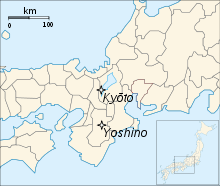Tenju
| History of Japan |
|---|
Tenju (天授) was a Japanese era name (年号, nengō, lit. year name) of the Southern Court during the Era of Northern and Southern Courts after Bunchū and before Kōwa. This period spanned the years from May 1375 to February 1381.[1] The Southern Court emperor in Yoshino during this time-frame was Emperor Chōkei (長慶天皇 Chōkei-tennō). The Northern court emperor in Kyoto was Emperor Go-En'yū (後円融天皇 Go-En'yū-tennō).[2]
Nanboku-chō overview
During the Meiji period, an Imperial decree dated March 3, 1911 established that the legitimate reigning monarchs of this period were the direct descendants of Emperor Go-Daigo through Emperor Go-Murakami, whose Southern Court (南朝 nanchō) had been established in exile in Yoshino, near Nara.[3]
Until the end of the Edo period, the militarily superior pretender-Emperors supported by the Ashikaga shogunate had been mistakenly incorporated in Imperial chronologies despite the undisputed fact that the Imperial Regalia were not in their possession.[3]
This illegitimate Northern Court (北朝 hokuchō) had been established in Kyoto by Ashikaga Takauji.[3]
Change of era
- 1375, also called Tenju gannen (天授元年): The new era name was created to mark an event or series of events. The previous era ended and the new one commenced in Bunchū 4.
In this time frame, Eiwa (1375–1379) and Kōryaku (1379–1381) were the Southern Court equivalent nengō.
Events of the Tenju Era
- 1375 (Tenju 1): Shogun Ashikaga Yoshimitsu visits the Iwashimizu Hachiman-gū where he worships publicly; and he offers a sword for the shrine's treasury, gold foil for the embellishment of the shrine, and a racehorses for the shrine's stable.[4]
- 1375 (Tenju 2): For the first time, Shogun Yoshimitsu is permitted to enter the precincts of the Imperial quarters at the Imperial palace in Kyoto.[4]
- 1377 (Tenju 2): Goryeo diplomatic envoy Jeong Mongju met with the shogunal deputy (探題 tandai) in Kyūshū, Imagawa Ryōshun. The objective of this diplomatic mission was to begin neogiating steps to control pirates (wakō).[5]
- 1378 (Tenju 4): Yoshimitsu moves into his new home in Muromachi;[6] and the luxurious house and grounds are called Hana-no-Gosho[7]
- 1379 (Tenju 5): Shiba Yoshimasa becomes Kanrei.[7]
- 1380 (Tenju 6): Kusunoki Masanori rejoins Kameyama; southern army suffers reverses.[7]
- July 26, 1380 (Tenju 6, 24th day of the 6th month): The former Emperor Kōmyō died at age 60.[8]
Notes
- ↑ Nussbaum, Louis-Frédéric. (2005). "Tenju" in Japan encyclopedia, p. 959; n.b., Louis-Frédéric is pseudonym of Louis-Frédéric Nussbaum, see Deutsche Nationalbibliothek Authority File.
- ↑ Titsingh, Isaac. (1834). Annales des empereurs du japon, pp. 312-316.
- 1 2 3 Thomas, Julia Adeney. (2001). Reconfiguring modernity: concepts of nature in Japanese political ideology, p. 199 n57, citing Mehl, Margaret. (1997). History and the State in Nineteenth-Century Japan. p. 140-147.
- 1 2 Titsingh, p. 312.
- ↑ Titsingh, p. 313; Kang, Jae-eun et al. (2006). The Land of Scholars : Two Thousand Years of Korean Confucianism, p. 159.
- ↑ Titsingh, p. 313.
- 1 2 3 Ackroyd, Joyce. (1982) Lessons from History: The "Tokushi Yoron", p. 329.
- ↑ Titsingh, p. 315.
References
- Ackroyd, Joyce. (1982) Lessons from History: The Tokushi Yoron. Brisbane: University of Queensland Press. ISBN 978-0-7022-1485-1
- Mehl, Margaret. (1997). History and the State in Nineteenth-Century Japan. New York: St Martin's Press. ISBN 978-0-312-21160-8; OCLC 419870136
- Nussbaum, Louis Frédéric and Käthe Roth. (2005). Japan Encyclopedia. Cambridge: Harvard University Press. ISBN 978-0-674-01753-5; OCLC 48943301
- Thomas, Julia Adeney. (2001). Reconfiguring Modernity: Concepts of Nature in Japanese Political Ideology. Berkeley: University of California Press. ISBN 978-0-520-22854-2; OCLC 47916285
- Titsingh, Isaac, ed. (1834). [Siyun-sai Rin-siyo/Hayashi Gahō, 1652], Nipon o daï itsi ran; ou, Annales des empereurs du Japon. Paris: Oriental Translation Fund of Great Britain and Ireland. OCLC 84067437
| Preceded by Bunchū |
Era or nengō Tenju 1375–1381 |
Succeeded by Kōwa |
